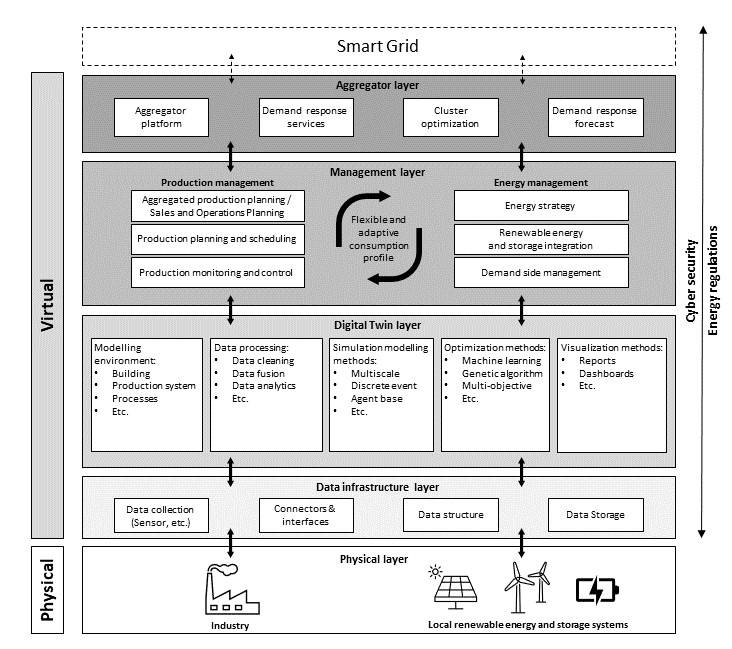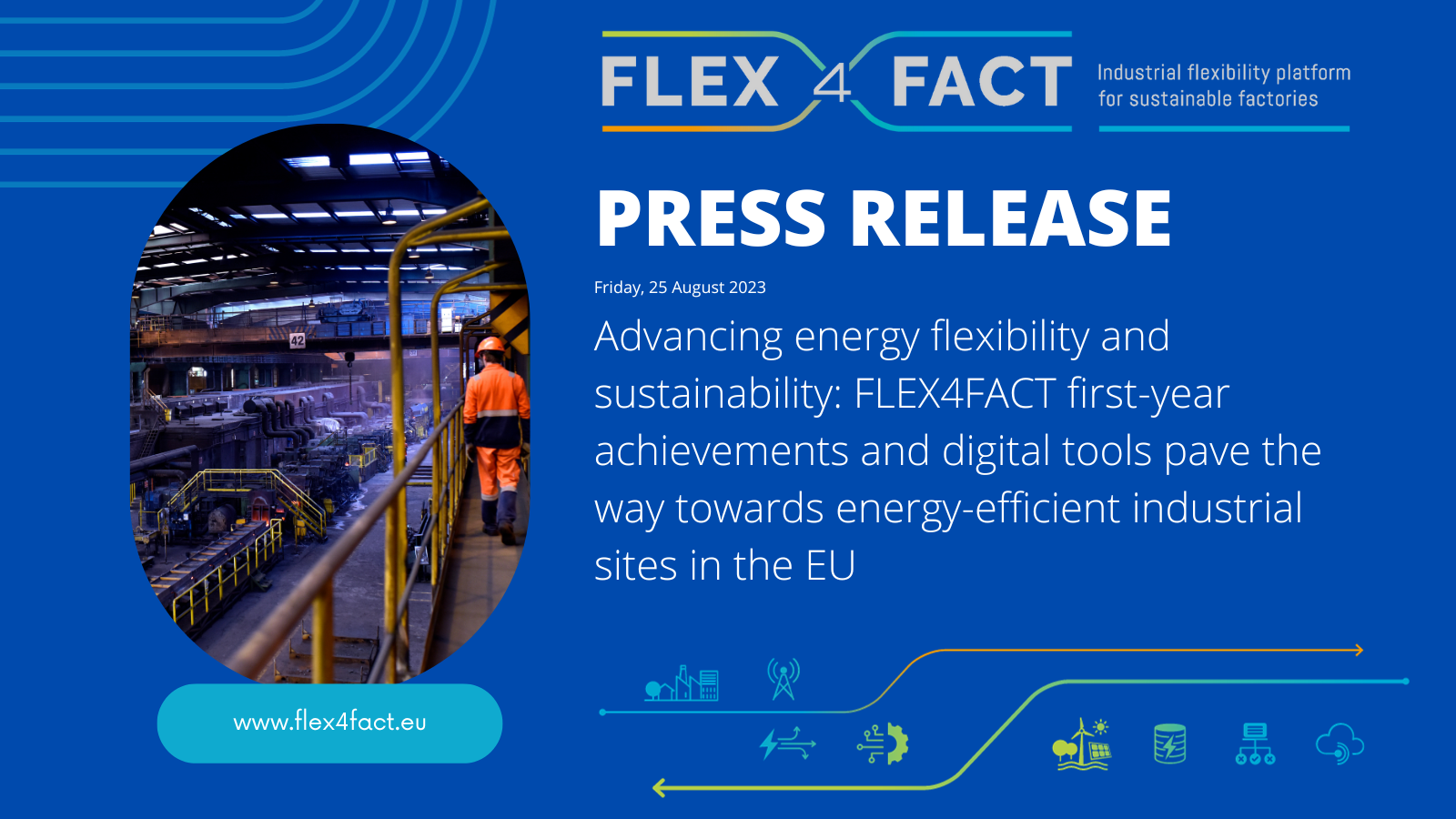Advancing energy flexibility and sustainability: FLEX4FACT first-year achievements and digital tools pave the way towards energy-efficient industrial sites in the EU.
Trondheim, August 25, 2023 – After more than a year of dedicated work, the FLEX4FACT project partners have made significant progress in optimising energy flexibility and demand-response services in the manufacturing industry. Following a detailed mapping of the five industrial use cases as an initial project step, first key results were achieved including the FLEX4FACT System Reference Architecture, the SanFlex Decision Support Tool, and the development of several Digital Twins.
FLEX4FACT’s tools and knowledge are expected to accelerate the digital and energy transformation of the industrial sector in Europe and support the uptake of new renewable sources in the EU power grid. Industrial partners will be able to reduce their dependence on fossil fuels, reduce energy costs and switch to renewable sources, while generating additional revenues through the provision of flexibility services. This will increase the competitiveness and the sustainability of the EU’s industry
The development of the FLEX4FACT framework as a key first project milestone
At the core of the FLEX4FACT project is its System Reference Architecture. This is a comprehensive framework that allows for implementation of demand-response in industries and improvement of the energy efficiency of manufacturing plants. It is based on literature review and workshops with experts and consists of different piled layers that interact with each other.
The framework comprises a physical layer and four virtual layers. The physical layer integrates local renewable energy generation and storage systems with production lines, which can provide flexibility services through smart management. The physical layer is connected to the data infrastructure layer, which ensures data consistency, interoperability, and system robustness. Collected data undergoes processing, enabling data-driven simulations by using detailed models located within the Digital Twin layer. It allows to simulate and optimise interaction between manufacturing processes and renewable energy sources, thus providing a baseline and scenarios supporting decision-making in the management layer. The management layer converts flexibility orders and/or efficiency targets into suitable energy production and storage scenarios and consumption profiles. The last layer is the aggregator layer, enabling manufacturing companies to connect with grid operators and to pool flexibility together. This architecture was developed in cooperation with the research centres of SINTEF Manufacturing, SINTEF Energy, UPC, IFE, RWTH, ALBSIG, and the technical partners Evolvere, Aingura, Capgemini, ITAINNOVA, and WE Plus. It is used as a reference concept within the FLEX4FACT project and facilitates the implementation of the technical activities and their interactions.

SanFlex – a decision support tool for inductrial flexibility
The SanFlex Decision Support Tool (DST) is a cross-industry tool for the visualisation of the energy flows of representative industrial use-case production processes based on Sankey diagrams, developed by project partner UCC. Based on real data from the investigated case study, SanFlex DST enables the user to visualise and understand the energy flow of the process in terms of costs and CO2 emissions.
Tool functions allow the user to visualise the potential impact of improved flexibility or on-site energy integration on energy distribution, consumption, and reuse. The tool provides a user-friendly interface where the results are presented in the form of side-by-side Sankey diagrams reflecting the energy flows in both the baseline and modified processes. This illustrative approach aids with the identification of flexibility potential and supports decision-making for managers and operators of industrial plants. The final version of SanFlex will include an option to input data, allowing for the analysis of further case studies and general applicability of the tool.
Digital twins developed for the FLEX4FACT use cases
The FLEX4FACT project is making significant progress in developing Digital Twins (DTs) to be able to simulate each case study. DTs are mathematical representations of industrial processes, capturing their essential features. They allow assessing the impacts of flexible production and renewable energy sources integration on production rate, energy consumption, and CO2 emissions. Since the FLEX4FACT project involves different use cases which are all very specific in terms of manufactured goods and processes, several DTs were or are currently being developed.
THEBEN, a German company specialised in electronics, aims to increase its self-production and to implement an energy management system allowing for detailed load monitoring. 3 DTs including a PV plant, a production line, and a soldering device are under development. CELSA, a key player in the steel manufacturing industry, seeks to optimise the provision of industrial flexibility of its steel plant melt shop in Barcelona. For this purpose, DTs of electric arc furnaces are being developed. INAVENTA SOLAR manufactures polymer flat-plate solar collectors through the extrusion of structured sheets. The company intends to implement a real-time energy management system to efficiently use renewable energy and excess heat. To make this possible, first a Finite Element Method model of the extrusion process was coded. The work focuses now on the creation of a real-time DT of the extrusion process, a DT of an on-site borehole thermal energy storage, and a DT to model the energy system of the factory. SEAC, a manufacturer of diving products, seeks to enhance automatic scheduling of its moulding lines to increase energy efficiency and reduce costs. A DT of its moulding machine is under development. Standard Profil, an industrial leader in sealing systems, works on the development of sensors for real-time quality monitoring during extrusion, the implementation of an energy monitoring system, and the coding of a DT for optimised control of its extrusion lines.
Further 1st year achievements and outlook
More achievements were made within the first year of the project when partners developed a so-called flexibility algorithm able to perform day-ahead scheduling of processes and decentralised energy resources based on detailed use case models and digital twins. It can for instance solve an optimisation problem like minimizing CO2 emissions by analysing input variables such as production baseline, available flexibilities, and electricity tariffs forecasts. Furthermore, progress was made on the industrial cluster flexibility platform, which pools flexibility and acts as intermediary to energy markets. An overall system diagram of the platform was developed and protocols for edge-cloud communication, cybersecurity were investigated.
In the upcoming months, FLEX4FACT partners will continue fine-tuning the main digital tools and will develop a comprehensive data gathering strategy ensuring smooth operation of the whole architecture. The next step consists of validating the DTs by comparing the results obtained from simulation with data gathered from experimental tests and developing an integration plan for the implementation of all FLEX4FACT solutions at use case level. An online webinar will take place in fall 2023 to showcase the first results of the project.
About the project
FLEX4FACT is a project funded by Horizon Europe running from June 2022 to November 2025. It aims to develop an end-to-end ecosystem based on a modular and multi-level architecture to enable flexible manufacturing in industries and create the conditions for the necessary energy transition in energy intensive industrial sectors. For more information, please visit www.flex4fact.eu.
